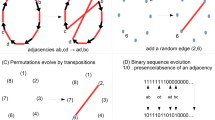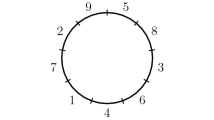Abstract
This paper introduces a new way to define a genome rearrangement distance, using the concept of mean first passage time from probability theory. Crucially, this distance provides a genuine metric on genome space. We develop the theory and introduce a link to a graph-based zeta function. The approach is very general and can be applied to a wide variety of group-theoretic models of genome evolution.



Similar content being viewed by others
References
Bafna V, Pevzner PA (1993) Genome rearrangements and sorting by reversals. In: 34th annual symposium on foundations of computer science, 1993. Proceedings. IEEE, pp 148–157
Bergeron A, Mixtacki J, Stoye J (2006) A unifying view of genome rearrangements. In: Bücher P, Moret BME (eds) Algorithms in bioinformatics. WABI 2006. Lecture notes in computer science, vol 4175. Springer, Berlin, Heidelberg, pp 163–173
Bhatia S, Egri-Nagy A, Serdoz S, Praeger C, Gebhardt V, Francis A (2019) A flexible framework for determining weighted genome rearrangement distance. preprint
Bowen R, Lanford III OE (1970) Zeta functions of restrictions of the shift transformation. In: Global analysis, proceedings of symposia in pure mathematics. Volume XIV, Berkeley, California, 1968
Butler RW, Huzurbazar AV (1997) Stochastic network models for survival analysis. J Am Stat Assoc 92(437):246–257
Clark C, Egri-Nagy A, Francis A, Gebhardt V (2019) Bacterial phylogeny in the Cayley graph. Discrete Math Algorithms Appl 11(05):1950059
Dalevi D, Eriksen N (2008) Expected gene-order distances and model selection in bacteria. Bioinformatics 24(11):1332–1338
Egri-Nagy A, Gebhardt V, Tanaka MM, Francis AR (2014) Group-theoretic models of the inversion process in bacterial genomes. J Math Biol 69(1):243–265
Francis AR (2014) An algebraic view of bacterial genome evolution. J Math Biol 69(6–7):1693–1718
Howard RA (1960) Dynamic programming and Markov processes. The Technology Press of M.I.T, Cambridge
Howard RA, Matheson JE (1971) Risk-sensitive Markov decision processes. Manag Sci 18:356–369
Humphreys JE (1990) Reflection groups and Coxeter groups, vol 29. Cambridge University Press, Cambridge
Jukes TH, Cantor CR (1969) Evolution of protein molecules. Mamm Protein Metab 3(21):132
Mason SJ (1953) Feedback theory-some properties of signal flow graphs. Proc IRE 41(9):1144–1156
Pyke R (1961) Markov renewal processes: definitions and preliminary properties. Ann Math Stat 32:1231–1242
Saitou N, Nei M (1987) The neighbor-joining method: a new method for reconstructing phylogenetic trees. Mol Biol Evol 4(4):406–425
Sankoff D, Leduc G, Antoine N, Paquin B, Lang BF, Cedergren R (1992) Gene order comparisons for phylogenetic inference: evolution of the mitochondrial genome. Proc Natl Acad Sci 89(14):6575–6579
Serdoz S, Egri-Nagy A, Sumner J, Holland BR, Jarvis PD, Tanaka MM, Francis AR (2017) Maximum likelihood estimates of pairwise rearrangement distances. J Theor Biol 423:31–40
Sumner JG, Jarvis PD, Francis AR (2017) A representation-theoretic approach to the calculation of evolutionary distance in bacteria. J Phys A Math Theor 50(33):335601
Terauds V, Sumner J (2019) Maximum likelihood estimates of rearrangement distance: implementing a representation-theoretic approach. Bull Math Biol 81(2):535–567
Wang L-S, Warnow T (2001) Estimating true evolutionary distances between genomes. In: Proceedings of the thirty-third annual ACM symposium on theory of computing. ACM, pp 637–646
Yancopoulos S, Attie O, Friedberg R (2005) Efficient sorting of genomic permutations by translocation, inversion and block interchange. Bioinformatics 21(16):3340–3346
Acknowledgements
ARF acknowledges the support of the Australian Research Council via Discovery Project DP180102215.
Author information
Authors and Affiliations
Corresponding author
Additional information
Publisher's Note
Springer Nature remains neutral with regard to jurisdictional claims in published maps and institutional affiliations.
Appendices
Appendix A. Evolutionary models
Table 2 shows a range of group-based models that this approach can be applied to. Each corresponds to a particular group and generating set.
Appendix B. Cayley graphs for \(S_4\)
The Cayley graphs of \(S_4\) with standard and with circular generators are shown for reference in Figs. 4 and 5 respectively.
Rights and permissions
About this article
Cite this article
Francis, A.R., Wynn, H.P. A mean first passage time genome rearrangement distance. J. Math. Biol. 80, 1971–1992 (2020). https://doi.org/10.1007/s00285-020-01487-w
Received:
Revised:
Published:
Issue Date:
DOI: https://doi.org/10.1007/s00285-020-01487-w






